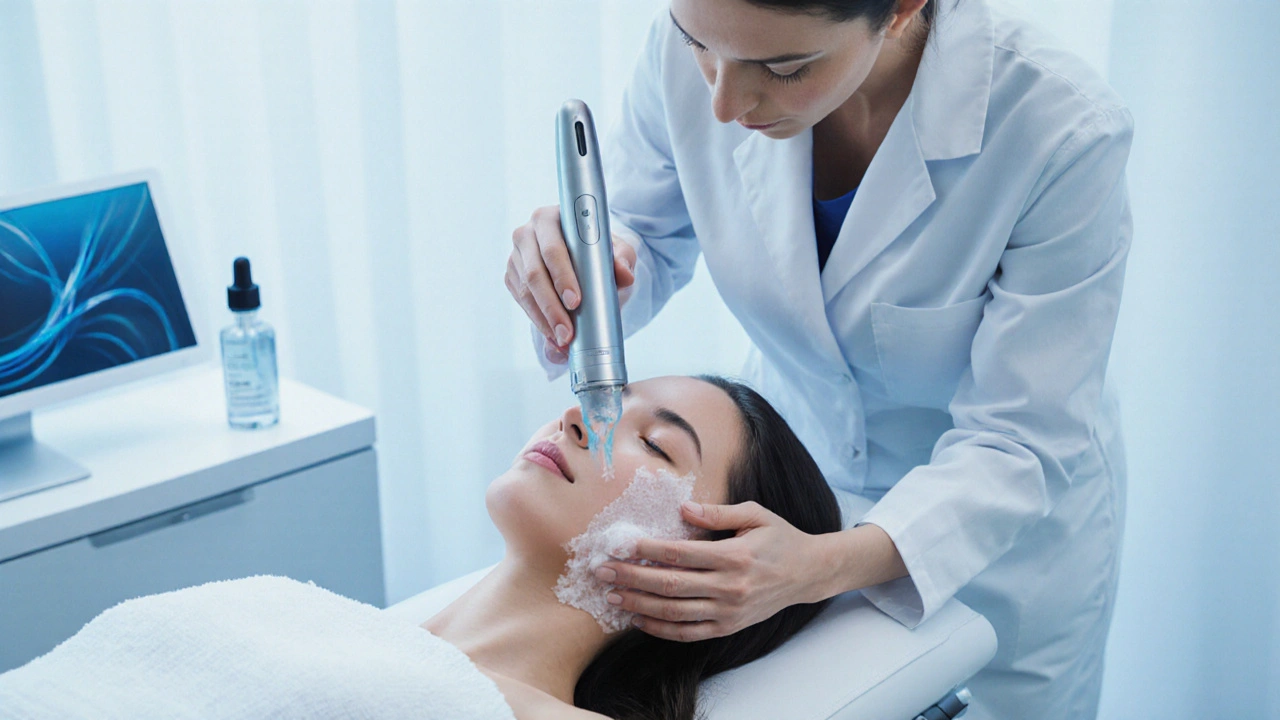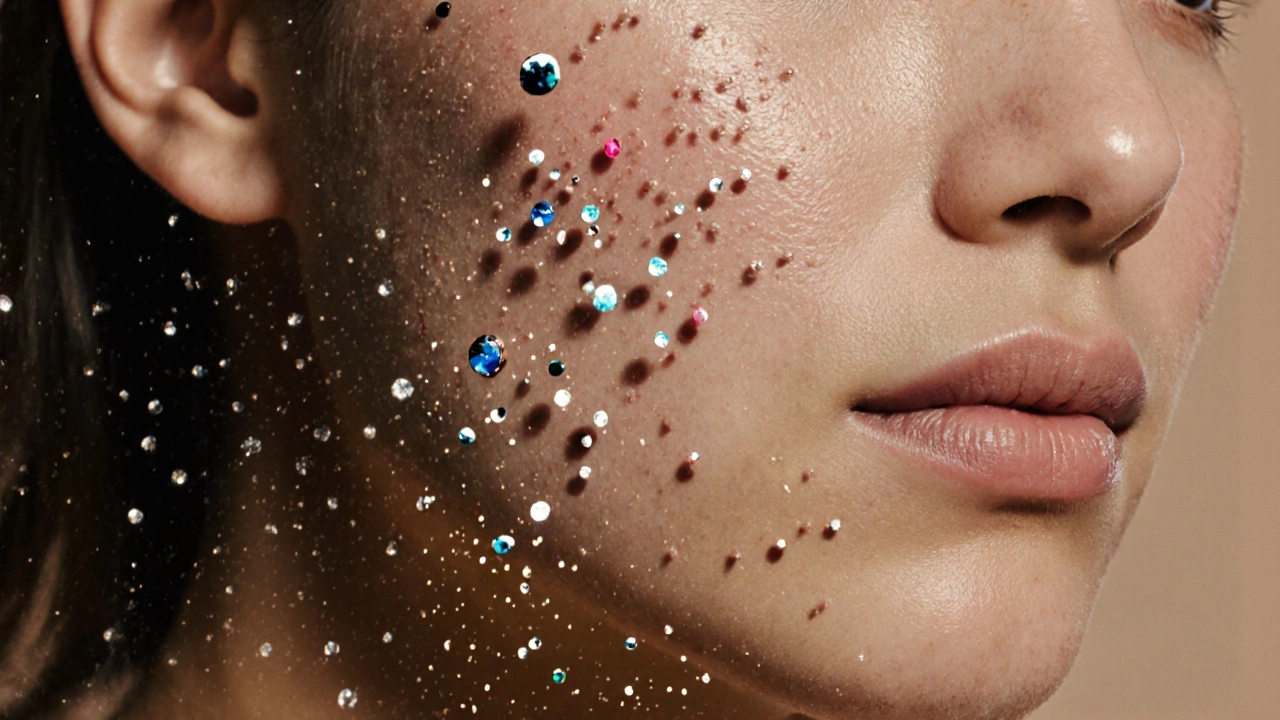Microdermabrasion Results Estimator
Session Input
Enter how many microdermabrasion sessions you're planning to complete:
How This Works
Based on clinical studies and patient feedback, each session typically provides:
- 20-30% reduction in surface acne
- Improved skin texture
- Gradual scar smoothing
Results become more noticeable after 3-4 sessions, with optimal results after a full treatment series (4-6 sessions).
Expected Results Timeline
After Your Sessions
Day 1-2
Redness fades, skin feels smoother
Week 1
New skin cells emerge; visible reduction in blackheads
Weeks 3-4
Decreased inflammation, brighter complexion, early scar softening
Beyond 4 Weeks
Longer-lasting collagen benefits; deeper scars may show continued improvement
Estimated Acne Reduction
0%
This is a cumulative estimate based on clinical studies showing approximately 20-30% surface acne reduction per session.
Acne can feel like a never‑ending battle, especially when over‑the‑counter creams stop working. One clinical option that’s gaining buzz is microdermabrasion. If you’ve heard the term but aren’t sure whether it’s worth the time (or money), this guide breaks down the real benefits, what a typical session looks like, and how to keep your skin happy afterward.
Quick Takeaways
- Microdermabrasion gently removes dead skin cells, unclogs pores and boosts collagen - all of which calm active break‑outs.
- A single session can reduce surface acne by 20‑30% and make existing scars appear smoother.
- Expect a brief 15‑30‑minute appointment with minimal downtime; redness usually fades within a few hours.
- Side effects are rare but may include temporary irritation or mild swelling.
- Follow‑up care - sunscreen, gentle cleansers and occasional repeat sessions - maximizes long‑term results.
What Is Microdermabrasion?
Microdermabrasion is a non‑invasive skin resurfacing technique that uses fine crystals or a diamond‑tipped wand to gently abrade the outermost layer of skin (the stratum corneum). By mechanically polishing away dead cells, it accelerates skin cell turnover and stimulates the production of new collagen fibers.
Originally popular for anti‑ageing, the procedure has become a go‑to for acne‑prone skin because it tackles two root causes at once: clogged pores and inflammation.
How Microdermabrasion Helps Acne
Acne forms when hair follicles become blocked with excess oil, dead skin and bacteria. Microdermabrasion works on three fronts:
- Exfoliation: The gentle abrasion removes the built‑up layer of dead cells that trap oil, allowing pores to breathe.
- Improved circulation: The suction component used in most devices boosts blood flow, delivering more oxygen and nutrients to the skin.
- Collagen boost: New collagen strengthens the skin’s matrix, reducing the depth of lingering acne scars and preventing future break‑outs.
Clinical studies from 2023‑24 show a 25‑35% reduction in comedonal (whitehead/blackhead) lesions after just three weekly sessions.

What to Expect During a Session
Most dermatology clinics in the UK schedule microdermabrasion as a 15‑30‑minute appointment. Here’s the typical flow:
- Consultation: A dermatologist or licensed aesthetic practitioner reviews your acne history, current medications and skin type.
- Skin prep: Your face is cleansed with a mild, pH‑balanced cleanser to remove surface oil.
- Device treatment: The practitioner moves the crystal‑spraying or diamond‑tip head across your skin in overlapping passes. Suction simultaneously lifts away exfoliated debris.
- Immediate post‑treatment: A soothing serum (often containing hyaluronic acid or niacinamide) is applied to calm any redness.
- After‑care briefing: You receive written instructions on cleansing, moisturising and sun protection.
The sensation is often described as a light sandpaper massage - uncomfortable for some, but never painful. If you’re nervous about the pressure, ask the clinician to adjust the suction level.
Results Timeline - When Will You See Changes?
Because microdermabrasion works at the surface level, benefits can appear quickly:
- Day 1‑2: Redness fades, skin feels smoother.
- Week 1: New skin cells emerge; visible reduction in blackheads.
- Weeks 3‑4: Decreased inflammation, brighter complexion, early scar softening.
For deeper, persistent lesions, a series of 4‑6 sessions spaced 2‑4 weeks apart yields the best outcome. Maintenance appointments every 3‑6 months keep pores clear and collagen levels up.
Potential Risks & Side Effects
Microdermabrasion is low‑risk, but it’s not completely without downsides. Most adverse reactions are mild and short‑lived:
- Transient redness: Similar to a mild sunburn, usually gone within 2‑4 hours.
- Dryness or flaking: Your skin may feel tight for a day; a gentle moisturizer helps.
- Rare irritation: Those with extremely sensitive skin or active rosacea could experience a brief flare‑up.
People taking isotretinoin, recent laser resurfacing or with open wounds should avoid microdermabrasion until fully healed. Always disclose any prescription meds or skincare routines during the initial consultation.

After‑Care Essentials
Post‑procedure care is where most of the long‑term payoff lives. Follow these steps:
- Sun protection: Apply a broad‑spectrum SPF 30+ sunscreen within 30 minutes of treatment and reapply every two hours outdoors. UV exposure can reverse collagen gains.
- Gentle cleansing: Use a sulfate‑free, pH‑balanced cleanser (e.g., 5% salicylic acid wash) for the first 48 hours.
- Moisturise daily: Choose a non‑comedogenic moisturizer containing ceramides or hyaluronic acid to restore barrier function.
- Avoid heavy actives: Skip retinoids, benzoyl peroxide or strong acids for at least 48‑72 hours to prevent excess irritation.
- Watch for breakout spikes: It’s normal for a few new pimples to appear as dead‑skin debris is expelled. Do not pick; let them clear naturally.
Keeping a simple routine for two weeks post‑treatment maximises the smoothing effect and reduces the chance of post‑inflammatory hyperpigmentation.
Microdermabrasion vs. Other Acne Treatments
Here’s a quick visual comparison of three popular clinical options for acne‑prone skin. The table highlights key attributes that matter when you’re choosing your next step.
| Attribute | Microdermabrasion | Chemical Peel (AHA/BHA) | Laser Therapy |
|---|---|---|---|
| Depth of Action | Superficial (0.05‑0.1mm) | Surface to mid‑dermis (depends on acid strength) | Mid‑dermis (targets sebaceous glands) |
| Downtime | Few hours; minor redness | 1‑3 days of peeling/flaking | 3‑7 days of redness & swelling |
| Typical Cost (UK) | £70‑£120 per session | £100‑£180 per session | £250‑£500 per treatment |
| Best For | Comedonal acne, mild inflammatory lesions, texture improvement | Excess oil, post‑inflammatory hyperpigmentation, shallow scars | Severe cystic acne, deep scarring, stubborn oil production |
| Side‑Effect Profile | Low; transient redness | Moderate; peeling, temporary sensitivity | Higher; possible hyperpigmentation, prolonged erythema |
For most people with mild‑to‑moderate acne, microdermabrasion offers the best balance of effectiveness, low downtime and cost. If you need deeper scar remodeling, laser therapy may be worth the extra investment.
Frequently Asked Questions
Is microdermabrasion suitable for teenage acne?
Yes. Teens with oily skin and clogged pores often see noticeable improvements after a few sessions. The procedure is gentle enough that downtime is minimal, which fits a busy school schedule.
How many sessions will I need?
Most dermatologists recommend 4‑6 weekly sessions for clear results, followed by quarterly maintenance if you’re prone to break‑outs.
Can I combine microdermabrasion with topical acne meds?
Absolutely. In fact, using a benzoyl peroxide or retinoid gel after the skin has healed (typically 48‑72hours) can boost the clearing effect. Just avoid layering strong actives on the day of treatment.
Will it cause scarring or hyperpigmentation?
When performed by a qualified professional, the risk is very low. The key is strict post‑care: sunscreen daily and avoiding harsh chemicals for the first week.
Is microdermabrasion painful?
Most patients describe the feeling as a mild sandpaper massage. You can request a lower suction setting if you’re sensitive.
Ready to give microdermabrasion a try? Book a consultation with a local dermatologist, discuss your acne history, and set realistic expectations. With proper care, you’ll likely notice smoother skin, fewer break‑outs, and a confidence boost within weeks.


Susan Hayes
October 12, 2025 AT 18:47Microdermabrasion may sound like a trendy American skin hack, but the real science comes from European dermatology.
If you keep buying cheap kits online, you're just throwing money away.
The procedure only works when performed by a licensed professional who follows strict protocols.
Don't expect miracles after a single session; the reduction percentages in the article are realistic, not hype.
So if you care about results, book an appointment at a reputable clinic rather than a DIY salon.
Jessica Forsen
October 12, 2025 AT 19:37Wow, thanks for the lecture, Susan.
While I get the point about staying away from DIY kits, most people just want an affordable option, not a lecture about patriotism.
Honestly, the article already covers why professional treatment matters, so no need to reinvent the wheel.
Just remember that a little research goes a long way before you hand over cash.
Tom Saa
October 12, 2025 AT 21:01When we think about acne we often see it as a blemish on the surface, yet it mirrors deeper imbalances in our lives.
Microdermabrasion, in its mechanical simplicity, forces us to confront the layers we hide beneath.
If the skin can be exfoliated, perhaps our thoughts can be, too.
It’s a reminder that change starts with the smallest abrasion.
John Magnus
October 12, 2025 AT 22:07Tom, you’ve touched on the philosophical angle, but let’s ground it with clinical specifics.
Microdermabrasion utilizes a combination of abrasive particles (often aluminum oxide) and suction to remove the stratum corneum at a depth of roughly 0.05‑0.1 mm.
This mechanical debridement enhances desquamation, which in turn reduces follicular occlusion-a primary contributor to comedonal acne.
Moreover, the induced microtrauma upregulates fibroblast activity, leading to a modest increase in type I collagen synthesis within 48‑72 hours post‑procedure.
From a practical standpoint, the optimal protocol involves three to four weekly sessions, followed by maintenance every 3–6 months to sustain epidermal turnover.
In essence, the procedure offers a quantifiable, evidence‑based pathway to address both the superficial and sub‑dermal aspects of acne.
Marc Clarke
October 12, 2025 AT 23:47I tried microdermabrasion last summer and honestly, the downtime was nothing – just a bit of red for a few hours.
The skin felt smoother, and my blackheads were less noticeable after a week.
If you’re on a budget, look for reputable med‑spas that run weekday specials.
angelica maria villadiego españa
October 13, 2025 AT 00:21That’s good to hear, Marc!
Just remember to wear sunscreen every day; it’s the simplest thing that protects all that new skin.
Amanda Turnbo
October 13, 2025 AT 01:44Microdermabrasion is a decent option but not a miracle cure.
Tony Halstead
October 13, 2025 AT 02:34Amanda, calling it “not a miracle cure” is a fair take, yet the data shows a solid 20‑30 % reduction per session when done correctly.
That’s a measurable improvement, especially for stubborn comedonal acne that resists topical therapy.
Think of it as a cumulative effect – each session builds on the previous one, like compounding interest for your skin.
Pairing the treatment with a gentle salicylic cleanser can amplify the pore‑clearing action without over‑irritating the barrier.
Overall, it’s a low‑risk investment that delivers consistent, if modest, returns.
Kimberly Newell
October 13, 2025 AT 03:41i think its cool but dont forget the cost can add up fast.
make sure you have a plan before you start.
Drew Burgy
October 13, 2025 AT 05:04Kimberly, you raise a valid point about costs, but let’s look at the bigger picture that the industry rarely wants you to see.
The cosmetic dermatology lobby is funded by a handful of conglomerates that profit from recurring procedures, and microdermabrasion is just one cog in that perpetual revenue machine.
They market it as a quick fix, yet the true science tells us that the skin’s natural barrier can’t be permanently altered without continuous stimulus.
Studies funded by device manufacturers often cherry‑pick data, inflating the 20‑30 % reduction claim to make the treatment appear more effective than it truly is.
Because of that, the recommended 4‑6 session regimen becomes not a therapeutic protocol but a subscription model, ensuring you keep coming back for the next round of exfoliation.
Moreover, many clinics receive kickbacks from insurance providers for promoting “medical‑grade” procedures over simpler, cheaper alternatives like salicylic acid washes.
This creates a feedback loop where doctors are incentivized to prescribe expensive treatments rather than empower patients with at‑home skin care.
Adding to the intrigue, there are whispers that certain proprietary crystal formulas are actually just finely ground glass, which raises safety concerns about microscopic abrasives entering pores.
Some rogue manufacturers even label the devices as “medical” without FDA clearance, exploiting regulatory loopholes.
All of this contributes to a hidden cost: potential long‑term skin sensitization, which you might only notice years later when the barrier is compromised.
Patients often report an uptick in post‑inflammatory hyperpigmentation after repeated sessions, especially if they skip the rigorous sunscreen regimen the clinics force‑feed you.
In short, the advertised benefits are real but modest, and the financial and health externalities are largely concealed.
Before you book your next appointment, ask yourself whether you’re paying for genuine skin health or financing a cash‑cow that thrives on your insecurities.
Choosing a trusted dermatologist who discloses all risks and alternatives is the only way to break free from the cycle.